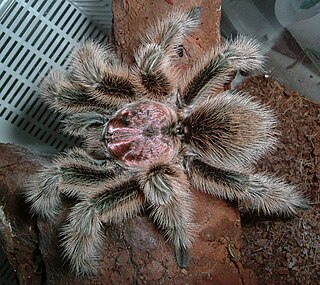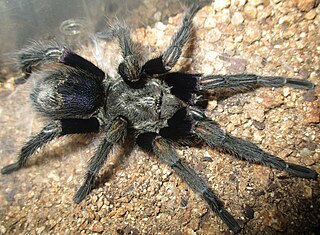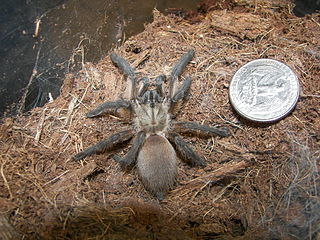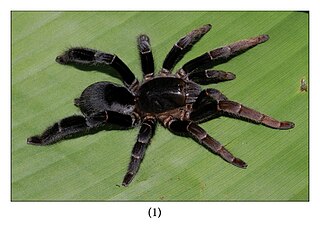
Grammostola is a genus of South American tarantulas that was first described in text by Eugène Louis Simon in 1892. These medium- to large-sized spiders are native to tropical South America, and are usually brown in color, with pinkish or orangish-red hairs. The very docile Chilean rose tarantula is popular as a beginner's spider among tarantula enthusiasts.

Idiopidae, also known as armored or spiny trapdoor spiders, is a family of mygalomorph spiders first described by Eugène Simon in 1889.

Barychelidae, also known as brushed trapdoor spiders, is a spider family with about 300 species in 39 genera.

Euathlus is a genus of South American tarantulas that was first described by Anton Ausserer in 1875. These spiders are medium sized and are usually found in high elevations in the Andes. It is a senior synonym of Paraphysa, and was formerly considered a senior synonym of Brachypelma, but this was later rejected.

Tarantulas comprise a group of large and often hairy spiders of the family Theraphosidae. As of December 2023, 1,100 species have been identified, with 166 genera. The term "tarantula" is usually used to describe members of the family Theraphosidae, although many other members of the same infraorder (Mygalomorphae) are commonly referred to as "tarantulas" or "false tarantulas". Some of the more common species have become popular in the exotic pet trade. Many New World species kept as pets have setae known as urticating hairs that can cause irritation to the skin, and in extreme cases, cause damage to the eyes.

Brachypelma albiceps is a species of spider in the tarantula family, Theraphosidae. It is known as the Mexican golden red rump tarantula or the Amula red rump tarantula. The carapace is a light golden color and the abdomen dark, covered with long red hairs. Females typically live for about 15 years. Males usually live about 5 years or up to 12 months after the last molt.

Heteroscodra is a genus of Central African tarantulas that was first described by Reginald Innes Pocock in 1900. Like many Old World tarantulas, they have a strong venom, and can inflict a painful bite. As of March 2020 it contains two species, found in Africa: H. crassipes and H. maculata.

Pachistopelma is a genus of Brazilian tarantulas that was first described by Reginald Innes Pocock in 1901. As of May 2020 it contains two species, found in Brazil: P. bromelicola and P. rufonigrum. They have a straight front eye row and males have a spinose spur on the first tibia. Females have two spermathecae lacking lobes or constrictions that have a slight curvature in the middle.
Anoploscelus is a genus of East African tarantulas that was first described by Reginald Innes Pocock in 1897. It was erected for the species Anoploscelus celeripes, based on a single male collected near Lake Tanganyika in modern day Tanzania. It was synonymized with Phoneyusa from 1985 to 1990. As of December 2019 it contains two species, including A. lesserti, first found in Rwanda in 1946.
Eumenophorus is a genus of Sierra Leonean tarantulas that was first described by Reginald Innes Pocock in 1897. As of March 2020 it contains two species, found in Sierra Leone: E. clementsi and E. murphyorum. It is considered a senior synonym of Monocentropella.
Loxoptygus is a genus of African tarantulas that was first described by Eugène Louis Simon in 1903. As of March 2020 it contains two species, found in Ethiopia: L. coturnatus and L. ectypus. It was removed from the synonymy of Phoneyusa, and is considered a senior synonym of Loxoptygella.

The Eumenophorinae are a subfamily of tarantula spiders. They are known from genera distributed across Sub-Saharan Africa, the south of the Arabian peninsula, Madagascar and its associated islands, and parts of India.
Eucratoscelus is a genus of East African tarantulas that was first described by Reginald Innes Pocock in 1898. As of March 2020 it contains two species, found in Tanzania and Kenya: E. constrictus and E. pachypus.

Lyrognathus is a genus of Asian tarantulas that was first described by Reginald Innes Pocock in 1895.
Plesiophrictus is a genus of tarantulas that was first described by Reginald Innes Pocock in 1899.
Brachionopus is a genus of South African tarantulas that was first described by Reginald Innes Pocock in 1897. It was transferred to the Theraphosidae from the Barychelidae in 1985.
Harpactirella is a genus of African tarantulas that was first described by William Frederick Purcell in 1902. Originally placed with the brushed trapdoor spiders, it was transferred to the tarantulas in 1985.
Spiroctenus is a genus of African mygalomorph spiders in the family Bemmeridae. It was first described by Eugène Louis Simon in 1889. Originally placed with the Ctenizidae, it was transferred to the funnel-web trapdoor spiders in 1985, and to the Bemmeridae in 2020. It is a senior synonym of Bemmeris, Bessia, and Ctenonemus.

Bassaniodes is a genus of crab spiders that was first described by Reginald Innes Pocock in 1903.
Spinosatibiapalpus is a genus of tarantulas erected by Gabriel and Sherwood in 2020 for a newly discovered species and two other previously described species bearing a unique palpal bulb morphology. The name is a reference to the spines found on the fourth section of the pedipalp in adult males. This distinctive feature was also found in Pseudhapalopus species, but because it is never mentioned in the original description of that genus, Gabriel and Sherwood called into question the validity of Pseudohapalopus, and moved all its species except P. aculeatus, known only from a single male found in Bolivia in 1907. It is impossible to place P. aculeatus because the holotype was destroyed when the museum housing it was bombed during World War II, and it has been declared as nomen dubium.










